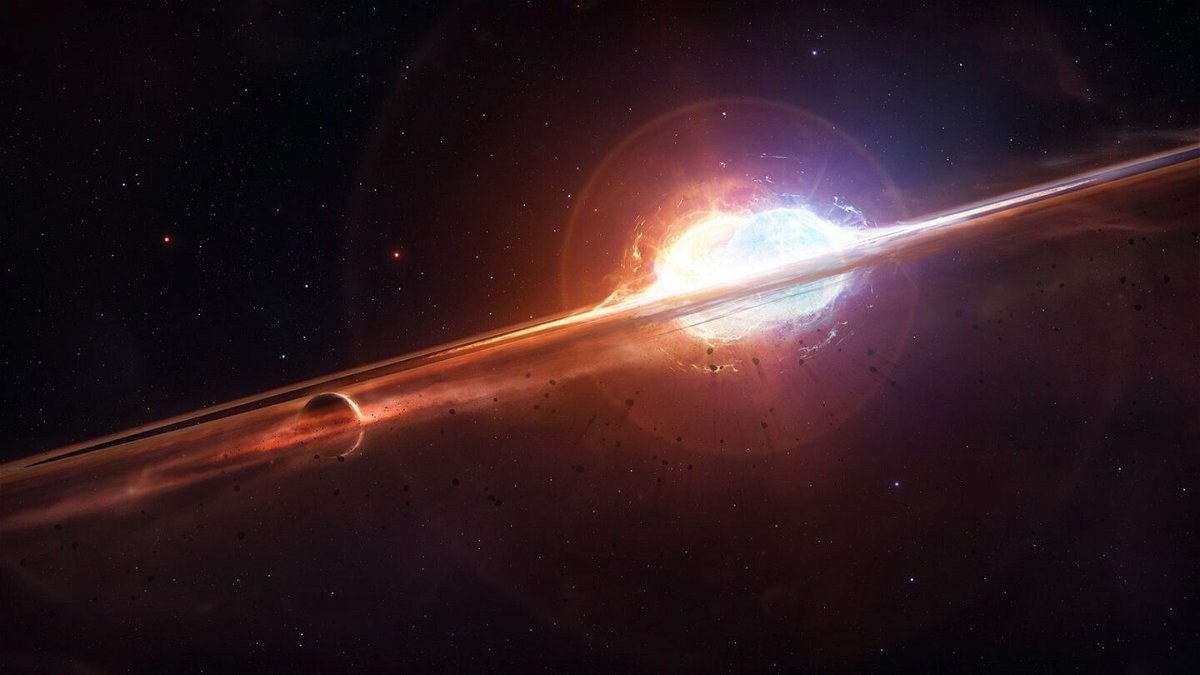Ghostly lights paint a new portrait of the Milky Way

A "hot Jupiter" exoplanet named Halla may have orbited two stars at one time.
By Ashley Strickland, CNN
(CNN) — The universe is filled with infinite mysteries, and scientists are tackling them, one celestial puzzle at a time.
A multitude of experiments were aboard Virgin Galactic’s inaugural flight on Thursday. A rocket-powered space plane carried the company’s first paying customers on a research-focused mission. During its brief time in zero gravity, the mission monitored how passengers’ heart rates behaved during acceleration and measured cosmic radiation in Earth’s upper atmosphere.
Meanwhile, the unprecedented capabilities of the James Webb Space Telescope continue to enable astonishing discoveries, including detecting a crucial molecule in space for the first time.
The European Space Agency is aiming to launch the Euclid mission this weekend, with an eye toward unraveling one of the biggest cosmic puzzles of our time — the increasing expansion of the universe — and the enigmatic forces behind it.
And that’s not all. This week, scientists shared glimpses into invisible aspects of the universe that could alter our understanding of the cosmos.
Across the universe
There is no shortage of scintillating imagery of the Milky Way galaxy — but we’ve never seen it from this perspective.
Astronomers used a detector sunk deep into the thick ice of Antarctica to trace “ghost particles” that created a new portrait of the Milky Way.
These ghost particles, called neutrinos, can pass through any kind of matter without changing. By tracing their origins across the galaxy, scientists were able to see our celestial neighborhood in a new way that could ultimately reveal the answers to bigger cosmic mysteries.
Another team of scientists detected new gravitational waves that resonate across the universe and “hum” in a celestial choir, like the background noise of the universe.
A long time ago
Thinking of ancient hunter-gatherer societies may call to mind a certain picture of men returning from hunting while women foraged. But new research flips those gender stereotypes upside down.
Archaeological evidence shows that women — young and old — hunted big game with bows and arrows, knives and nets. Sometimes the hunters worked alone, or alongside children and dogs. And these women even shared their knowledge and strategies with others.
The research got its start in the Andes Mountains after scientists unearthed a set of 9,000-year-old remains buried with an array of hunting weapons and assumed the skeleton was male. DNA analysis told a different story.
Fantastic creatures
At first glance, you might think you’ve wandered into the Beatles’ mythical “Octopus’s Garden.”
Scientists were surprised to discover an active octopus nursery on an underwater mountain nearly 2 miles (3,218 meters) down off the Pacific coast of Costa Rica. The research team believes the area may be only the third known example of a brooding site where huge numbers of the creatures cluster together.
The rare sighting in the ocean’s twilight zone was made by an underwater craft during an expedition of the Schmidt Ocean Institute’s Falkor research ship.
Researchers captured spectacular footage of hundreds of octopuses hatching babies as well as other deep-ocean life.
Turn, turn, turn
Summer is here — and so are the mosquitoes. As the world warms due to the climate crisis, the annoying insects are thriving and even appearing in new places.
Rising temperatures allow mosquitoes to grow faster, live longer and even become more infectious.
Scientists are still trying to understand the particular factors that may draw mosquitoes to certain people.
But experts agree on some tried-and-true tips to avoid mosquito bites, like using insect repellent and dumping standing water from your yard.
Other worlds
About 520 light-years beyond our solar system, astronomers have found a planet that shouldn’t exist.
The exoplanet, named Halla, may have survived a violent outburst from the giant star it orbits called Baekdu.
As stars age, they burn through different elements at their core and swell in size, which is usually bad news for any world close enough to become engulfed by the transition. It’s a fate Earth is likely to experience in 5 billion years.
But astronomers have theories about this unlikely survivor of an event that would mean certain death for most planets.
Discoveries
These stories might make you do a double take:
— Killer whales won’t stop ramming boats in the Strait of Gibraltar near Spain, and experts have two theories as to why.
— Humans have pumped so much groundwater for drinking, livestock and crops that Earth’s axis has shifted.
— Researchers have made a startling fossil find that suggests our ancient human relatives butchered one another for reasons beyond ritual.
— The Perseverance rover snapped a new photo of a mysterious doughnut-shaped object on the Martian surface.
The-CNN-Wire
™ & © 2023 Cable News Network, Inc., a Warner Bros. Discovery Company. All rights reserved.
